Want to write persuasive Facebook ad copy that sells? Wondering how to get your Facebook ads to work better?
To explore what marketers need to know about writing Facebook ad copy that converts, I interview Molly Pittman on the Social Media Marketing Podcast.
Molly is a Facebook ads strategist and co-host of the Perpetual Traffic podcast. Her course is called Train My Traffic Person.
Molly provides a three-part framework to follow for creating Facebook ads that work and shares three hooks to build your ads around.
Listen to the Podcast Now
This article is sourced from the Social Media Marketing Podcast, a top marketing podcast. Listen or subscribe below.
Where to subscribe: Apple Podcasts | Spotify | YouTube Music | YouTube | Amazon Music | RSS
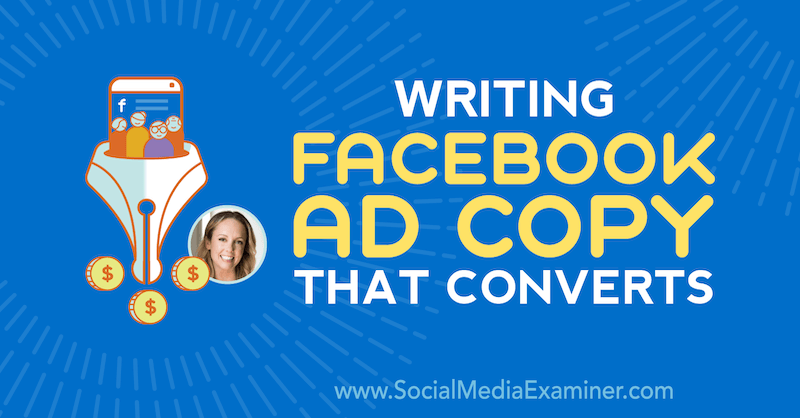
Keeping Up With Facebook Ad Changes
In August 2019, Facebook changed the visual design of ads, which also reduced the amount of visible ad copy on the news feed. Only three lines of primary text are now shown on the mobile news feed, which is where most mobile traffic comes from. After these three lines, people have to click a prompt to continue reading.
This is a big shift because Facebook used to display about double that amount of text by default. This increases the urgency of capturing consumer attention much earlier in the ad copy. Getting more clicks to keep reading is also an indicator to Facebook that the ad is engaging, which will help your diagnostic scores.
Facebook has also quietly added the ability to retain certain text formats in pasted-in ad copy. Molly uses a tool called YayText to bold or italicize certain words, and then she copies and pastes the text right into the ad. This functionality isn't native inside of Ads Manager but if you set up your text formatting inside one of those tools and then copy and paste it into an ad, Facebook will now retain the formatting. This even works in groups, which also recently obtained formatting features.
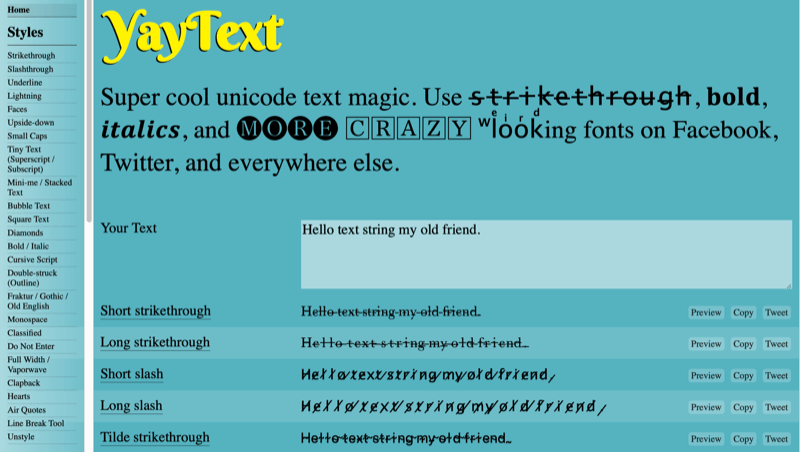
Use this feature sparingly as too much formatting can make your ad hard to read. But it's a great way to draw attention to certain pieces of text that matter most, as well as to stand out from other advertisers because most people don't yet know that you can format ad text.
Why Is Facebook Ad Copy so Important?
Facebook advertisers often focus on the visual creative—the video or the image—but the ad copy is equally important. If your ad has really strong visuals but the copy is mediocre, you're missing out on a huge portion of your market that's more likely to read your ad.
The ad copy is the articulation of the hook; it's the reason that a consumer should take the action you're asking them to take. Whether you're asking them to watch a video or opt into a lead magnet, that ad copy is where you “meet them in the conversation that's already going on in their mind,” as Dan Kennedy says. Then transition that conversation into your call to action and how that will benefit them.
Get World-Class Marketing Training — All Year Long!
Are you facing doubt, uncertainty, or overwhelm? The Social Media Marketing Society can help.
Each month, you’ll receive training from trusted marketing experts, covering everything from AI to organic social marketing. When you join, you’ll also get immediate access to:
- A library of 100+ marketing trainings
- A community of like-minded marketers
- Monthly online community meetups
- Relevant news and trends updates
A lot of Facebook marketers still think they can launch ads that just explain their offer or talk about how great their product or service is, which doesn't work anymore.
Focus on the “Why”
The real skill when it comes to ad copy is the “why.” The best way to describe this is something that Ryan Deiss of DigitalMarketer calls the “before and after grid.” Whenever Ryan is trying to sell a product or service, he uses this grid to help him figure out the transition that he's actually providing to the end user.
So before you ask your audience to opt into your webinar next week, figure out the “before” state of your market right now.
What pain points are they struggling with? What's their emotional state? What are they dealing with in their day-to-day lives? After they consume your webinar, what does it do for them? What's the “after” state? How will their lives improve? If you take the time to figure that out and it's all laid out in front of you, then the ad copy is easy. That's what most people are missing—the “why”—and that's why copy is so important.
Nobody goes to Facebook looking for ads. They go there for a different purpose. They're not searching for your solution. They're there with a different intent and then you interrupt them with your ad. To avoid being zoomed right past, it's got to connect with them.
3 Types of Hook to Use in Your Facebook Ads
It all starts with the “hook,” and Molly has three favorite categories of hook that anyone can use.
Pain/Benefit
Speak to a pain point that you know this particular avatar has. Then speak to a benefit, the “after” state—that desired outcome they hope will solve the pain point they're experiencing.
A good example of this comes from a company called Dog Training Secrets, which sells dog training video courses. They've got a really simple pain/benefit ad that says, “Does your dog get way too excited and out of control when he sees something he wants in his environment? Watch this video to discover one clever trick for how to finally start teaching your dog to calm down on command, then click here to learn more.”
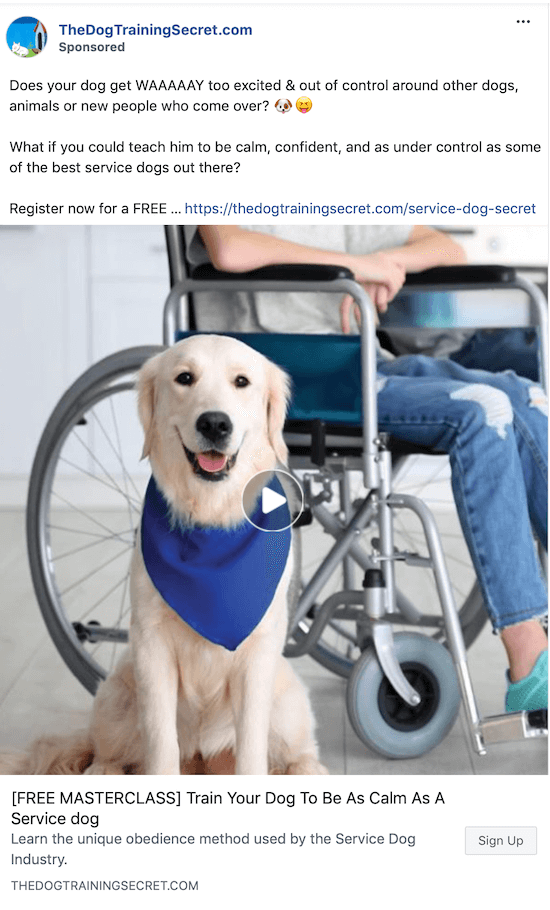
This is really simple. It opens with that pain point, “Does your dog get way too excited and out of control when he sees something he wants in his environment?” If you have a dog that's doing that, it's a huge pain point. It's frustrating. The company is coming right out and speaking to that pain point and then transitioning into the benefit and speaking to the “after” state: “Watch this video to discover one clever trick for how to finally start teaching your dog to calm down on command.”
This could be long copy or short copy. It's just a very simple hook and framework that you can use with almost any audience.
What pain point does your offer solve that you want to promote? Lead with that, because it's going to catch the attention of people who are experiencing that pain point. Then transition into the “after” state that they're looking toward, where your offer allows them to solve the pain point.
Feelings-Based Hook
Every market has empaths. Molly herself identifies as hugely empathetic and finds that marketing that speaks to her feelings usually attracts her. A lot of your market, any market, is the same way.
Use feelings, but never use someone's feelings against them. As marketers, we have a lot of power to influence how people feel about themselves and other things, and we should always use that for good. It can be very powerful if your product or service can improve how someone feels.
A good example of this is from a health supplement company called Organifi. The ad says, “Six months from now, when people come up to you and they ask, ‘What have you been doing? I want some of that. Whatever it is, you look amazing,' you can't put a price tag on that feeling. Shop today and see how Organifi makes you feel.”
If your offer is something that really transforms someone's life, play to the associated feelings. Speak to an undesirable “before” state and how that feels, or to the “after” state like Organifi did, or even both. Molly often markets to the marketing community so she speaks to how frustrating Facebook ads can be.
To help you find this hook, survey your customer base if possible. Molly had a client called Panda Planner that sells planner books. It can be hard to find a “feelings” hook in that so Molly sent out a survey and incentivized people with a free product to answer a few simple questions.
One of them was, “What was your life like before Panda Planner?” The second one was, “What was your life like afterward?”, then “How does it make you feel?” as a Part B. The third question was, “If you were recommending this to a friend, what would you say?”
The ad copy that ended up working best was from someone who had been going through a divorce. Their finances were a mess and their life was in shambles. Then their Panda Planner showed up and they got a job and paid off their debt. It was a whole life story that came out because Molly asked the right questions.
Logic Hook
Find a logic statement or a fact that proves your point very early in the ad copy so people who are very logic-based immediately agree with you and want to continue.
Molly ran ads for a company that turns plastic water bottles into art. She wanted to open with a logic statement that helped people understand what a big problem it is to have all of this plastic in the ocean.
The ad opened by stating, “The Great Pacific Garbage Patch, a collection of plastic floating trash, halfway between Hawaii and California, has grown to more than 600,000 square miles,” citing USA Today as the source. The ad then went into the call to action for the product and why they created it. But just starting out with a staggering stat like that also helped with social proof because people want to share that information with the world.
With a logic hook, the premise is that we need to present some sort of data point that's fairly undisputed and factual in nature to stop readers and get them to pay attention. And it doesn't always have to be a data point or a number.
For example, Molly has a student who helps women balance their diet with their hormones. A good logic ad for that client could begin with, “Did you know that your hormones change week to week and your diet should match that?” That's just pure education because most people who read that didn't know that information before. They're immediately interested now because this information has caught their attention and they want to continue reading.
Molly works with another brand called Pela Case, which makes a phone case that can be composted in 30 days. The hook that works the best for them is, “Did you know there are one billion plastic phone cases thrown into landfills every year?” Most people don't know that so it catches their attention and they want to keep learning.
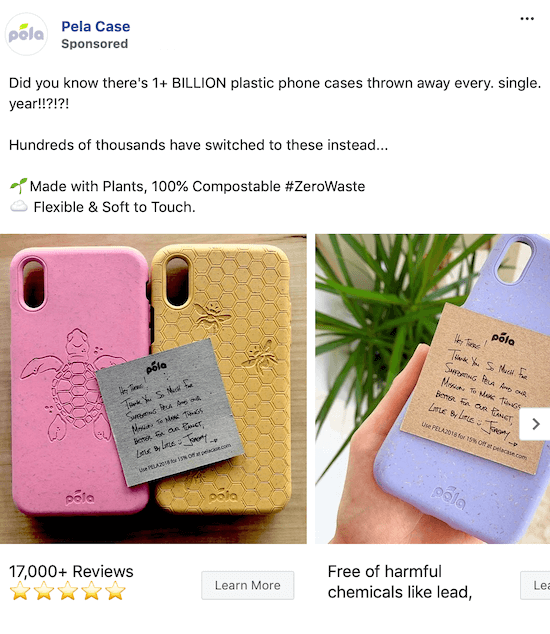
Molly makes sure to pick multiple hooks for each campaign, not just relying on one, because even if your audience shares some commonalities, they're also inherently different people, or at least experiencing very different days. Some might be feeling emotional today and might respond to more feelings-based ad copy. Some are more likely to respond to ad copy that's more logical. Maybe they're experiencing a certain pain point today that you just happened to call out in your ad copy.
Molly recommends coming up with a hook in each of the three categories—pain/benefit, feeling, and logic—and testing them. She recommends trying to include at least two per campaign so you're able to reach as many people as possible in your market based on their emotional state and what they're experiencing.
Follow a 3-Part Facebook Ads Framework
Molly has a three-part framework that she uses to write the ad once she's discovered her hook.

Discover Proven Marketing Strategies and Tips
Want to go even deeper with your marketing? Check out the Social Media Marketing Podcast! Publishing weekly since 2012, the Social Media Marketing Podcast helps you navigate the constantly changing marketing jungle, with expert interviews from marketing pros.
But don’t let the name fool you. This show is about a lot more than just social media marketing. With over 600 episodes and millions of downloads each year, this show has been a trusted source for marketers for well over a decade.
A side note before we dive into the framework. Molly is often asked how long Facebook ad copy should be. Short and long copy each work well in different scenarios. When Molly builds a campaign, she tries to include a variety of lengths because some people are more likely to read short ad copy and some people are more likely to read long ad copy.
Keep that in mind as we go through Molly's framework and don't focus on the length of the ad copy. It should be as long as you need to properly portray that hook and what you're really trying to say to the audience.
The Opening
This is the most important part of your Facebook ad copy. If you're writing shorter ad copy, this might just be the first sentence. If you're writing longer ad copy—for instance, if you're writing stories in your ad copy, which can sometimes work well—it could be the first few paragraphs.
This part is especially crucial on mobile because so much less text is being shown. If you don't catch people's attention in step one, they're never going to make it to steps two and three. And whether your copy is long or short, your opening needs to show up in those first two or three lines before the More button.
In your opening, you need to do two things:
Call out your audience: You don't need to write, “Hey, social media managers, this is for you,” but the ad copy does need to use words that suggest who the ad is for.
For example, if we were selling some sort of coffee alternative to moms, that ad copy could open with, “As a mom, I know how many sleepless nights you're enduring.” We're not saying, “Hey, moms,” but we're indicating whom we're speaking to. Whenever you can do that, it's going to work so much better because that person knows it's for them, and they're most likely to continue to read the ad copy.
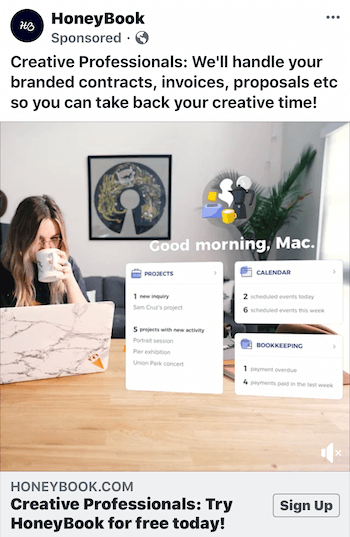
Pique their curiosity: This could be a promise to solve one of their pain points or educating them with a logic statement like we talked about earlier. This could also involve doing something that's curiosity-based like asking them a question or even doing a pop quiz in Messenger. Whatever it is, you need to spark that curiosity without being overly hyping. That's going to help with the consumption of the ad and that person will continue to engage with you.
A big mistake people often make in this opening section is they put too much fluff in it. Usually, after Molly writes ad copy, she deletes the first sentence or two; for some reason, she finds that the first stuff she writes is usually pointless. Definitely look out for that tendency.
A great example from Panda Planner was the beginning of an actual testimonial that Molly got in response to her survey questions. It says, “My mom life is more organized with Panda Planner. I have one place to keep our doctor's appointments, school activities, school trips we go on, etc. It's also nice to keep up with cleaning around the house, when I need to do it, what room was deep cleaned last, etc. It keeps me accountable on what I plan on getting done for the day, week and month.”
That's a bit long, but it's obviously speaking to moms and speaking to a bunch of pain points they have, in their own words.
The Transition
One big mistake people make is to say, “Hey, do you want your dog to quit acting crazy in its environment? Do you want your dog to quit barking? Buy my product now!” They catch someone's attention but it feels so forced, and just goes right into the call to action.
Use a transition to really massage that pain point or that “after” state. This is where you're leading the horse to water so the consumer doesn't feel like they're being directly sold to. The transition is where you go from the introduction to the “how.” Your call to action is the vehicle that's going to get them to that “after” state.
If you have testimonials to back up your opening, that could go in the transition. To continue the example of the earlier ad for Panda Planner, the transition went on to say, “I love that the dates are not pre-printed because I can set my year to a school year instead of a calendar year. I'm going into my second Panda Planner. It's big, so I don't lose it.”
They had just talked about how her life was more organized and then they transitioned more into the product—but it's not a call to action yet. This was the transition. They're talking more about the product here. “It's sturdy and strong and can withstand being carried around with lots of school books and pens. The pages are thick so I can use gel pens and they don't bleed through. I have a place to keep up with meal planning. I seriously can put everything in this planner I need. I love this planner.”
And then the call to action: “Panda Planner is scientifically proven to increase productivity and happiness. Get more done, feel better, 10% off. Use code ‘Facebook 10' at checkout.”
Here's another example. The dog training company asked, “Does your dog get way too excited and out of control when he sees something he wants in his environment?” The transition is, “Watch this video to discover one clever trick for how to finally start teaching your dog to calm down on command.” They transitioned into that “after” state and then said, “Click here to learn more.”
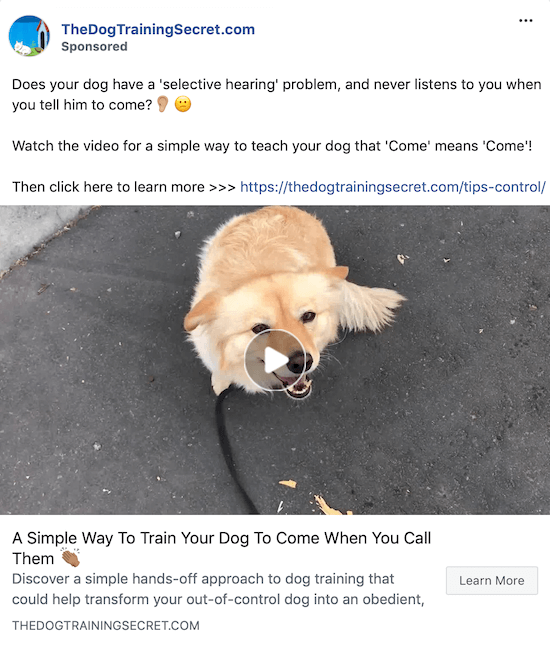
People watched the video and the ad, and then they clicked to get a free training. That's almost like two calls to action because you're asking them first to do something, and then to do something else, but at least it had a transition before saying, “Go do this now.”
A good transition can be short or long. Here's an example of a really short one from Drew Canole of Organifi; this is a shorter ad from his personal page. The opening is, “Five years ago, I had my very first green juice, and it changed my life.” That generates curiosity. The transition is, “I started feeling better; I had more energy, curbed my cravings, and experienced the most radical transformation.”
So the transition is when we start to speak more about the product and what it does, whereas the intro is more about the end user, the avatar, the market that you're speaking to. The transition is where you start to transition how they're wanting to feel (or whatever hook you're using) into your product. Then he said, “Need some help with your own transformation? Click here to learn about how we can help.”
In the first step, you're entering a conversation about them; the transition is where you start to transition into talking about your product; and then the third step is your call to action. Molly often color-codes these steps when she's planning out her campaigns—step one, step two, step three—so that she can visually make sure all three of those elements are there.
The Call to Action
We know that people are more likely to take an action if they're told to do it. It's why we're taught when there's an emergency situation, point at someone and tell them to call 911. If you don't tell someone to do it, people just won't take action. That's how we work as humans.
Obviously, you have a call-to-action button built into the ad itself, below the image. Also put it in the text for people who are readers. Molly always puts a link in the text too because some people, especially when using video, just don't know that they need to click on the gray area below the video to actually go over to the URL.
The call to action should be short and sweet: nothing more than three sentences. If you have a discount code, this is the place to mention that. Tell them exactly what to do, whether it's to watch something, opt in, buy this, whatever it is you want.
You might even add a few more benefits there at the end. For Panda Planner, it said, “Panda Planner is scientifically proven to increase productivity and happiness. Get more done, feel better, 10% off, use code ‘Facebook 10' at checkout,” and the link was there. For Organifi, it said, “Need some help with your own transformation? Click here to learn about how Organifi can help.”
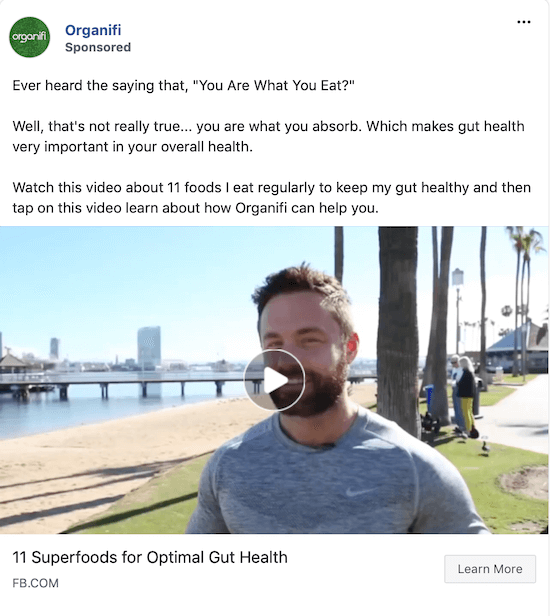
Temper the Hype in Your Facebook Ad Copy
Try to use words like “buy this” as little as possible because Facebook indexes that. Molly has seen ad accounts shut down for using “exaggerated language.” Definitely have a call to action and tell them what to do, but know that Facebook is indexing for really aggressive typical calls to action like “Time is running out,” “Supplies are limited,” “Buy now,” “Last chance,” and so on. That's hurting you, and Facebook is actually ranking based on it.
One of Facebook's new ad diagnostics is quality ranking. But the conversion ranking, the diagnostic that measures your post-click experience, is where Facebook is indexing the copy on your landing page. The quality ranking, which is measuring the quality of your actual ad, is where Facebook is reading your ad copy.
It's a bot looking for words that might suggest, “This is too hypey.” And it's why a lot of people are getting notifications like, “Hey, this is MLM,” or, “Your ad account's shut down because you're selling work from home offers.” They have certain language that alerts their system of those things, which is important to keep in mind.
Key Takeaways From This Episode:
- Follow Molly on Facebook and Instagram.
- Check out Molly's podcast, Perpetual Traffic.
- Take Molly's Train My Traffic Person course when it opens again in January.
- Format your ad copy with YayText.
- Find out more about Dan Kennedy and DigitalMarketer's Before & After grid.
- Check out Social Media Marketing World 2020.
- Watch exclusive content and original videos from Social Media Examiner on YouTube.
- Watch our weekly Social Media Marketing Talk Show on Fridays at 10 AM Pacific on Crowdcast.
Help Us Spread the Word! Please let your Twitter followers know about this podcast. Simply click here now to post a tweet.
If you enjoyed this episode of the Social Media Marketing podcast, please head over to iTunes, leave a rating, write a review, and subscribe. And if you listen on Stitcher, please click here to rate and review this show.
What do you think? Will you try this framework for creating Facebook ads? Share your thoughts in the comments below.
Attention Agency Owners, Brand Marketers, and Consultants

Introducing the Marketing Agency Show–our newest podcast designed to explore the struggles of agency marketers.
Join show host and agency owner, Brooke Sellas, as she interviews agency marketers and digs deep into their biggest challenges. Explore topics like navigating rough economic times, leveraging AI, service diversification, client acquisition, and much more.
Just pull up your favorite podcast app, search for Marketing Agency Show and start listening. Or click the button below for more information.

